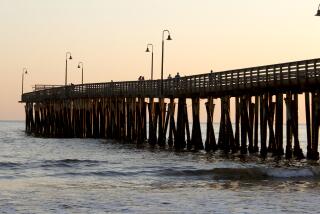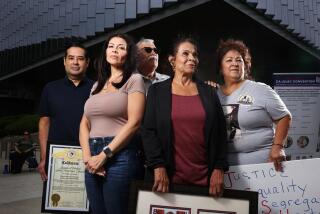Are Bungalows From the 1920s Boon or Blight?
CORONADO — Showing a lack of appreciation for the city’s architectural history, Coronado’s government is considering tearing down a historic bungalow court apartment complex to make way for a police station.
The Babcock Court apartments at Orange Avenue and 7th Street were built in 1922 in the classic Mediterranean revival style of the day. They capture the spirit of their era in clean, economical fashion.
One of only two bungalow court complexes in Coronado, Babcock Court is a fine example of a housing type that flourished in Southern California in the 1920s and 1930s, offering affordable, detached homes for those of modest income. The central courtyard was a communal social spot, lending some sense of family to groups of unrelated individuals who lived in the 10 bungalows and one 4-unit cluster.
In its fight to save the complex, the Coronado Historical Assn. is trying to get Babcock Court, which is owned by Coronado, added to the National Register of Historic Places next month. Though this is no guarantee of saving the homes, it would help the cause. If nothing else, it would provide prestigious recognition of their historic merit.
Proponents of preserving the bungalows, whose architect is unknown, have squared off against public officials and citizens who question the complex’s historic merits and the large sums of public money that would be needed for preservation. Restoring Babcock Court--possibly for civic organizations or for other city or public purposes--could cost $750,000 to more than $1 million.
Each charming, flat-roofed one-bedroom stucco cottage has clay-tiled awnings and exterior parapet walls reminiscent of California missions. Interiors include built-in writing desks and cabinets, fireplaces, modular metal kitchen appliance-counter
units that were state-of-the-art in their day, and an arched, beveled glass window flanked by built-in display alcoves.
Ironically, this modest, unassuming area is stirring up a big controversy.
Last fall, Coronado voters turned down a proposal for a new $10-million civic center for the site. City Manager Homer Bludau attributes the vote primarily to public sentiment against such a sizable expenditure, but also to rising support for preserving Babcock Court.
Now, the city wants to build a police headquarters on the property and a vacant lot next to it. Both pieces of land are owned by the city, which is waiting for an environmental impact report on the proposed police station, a building of 20,000 to 24,000 square feet.
An alternate site for the station is another lot south of the city’s vacant lot, but that land could cost more than $1 million.
“There is a group in town who are dilettantes, not true historians, and they stir up all kinds of mischief,” said Carol Cahill, a longtime local resident and civic activist. She doesn’t believe Babcock Court has historical merit, and she thinks the city would waste millions of dollars by preserving the building and constructing a police station on other land.
She cited several other apartment complexes she believes are more noteworthy bungalow courts. But they are not true detached bungalows. They consist, instead, of apartment buildings arranged around courtyards in bungalow court fashion.
“We reviewed a list of bungalow courts claimed by Carol and her associates and found only two,” said architect and Coronado resident Chris Ackerman, a board member of the Coronado Historical Assn.
The association’s push to list the property with the National Register of Historic Places appears to be a shoo-in, but city leaders remain mostly unmoved by this jewel of period architecture in their midst.
Mayor Mary Herron, an advocate in the past of leveling the apartments to make way for new civic buildings, now says she won’t commit herself one way or another until the environmental impact report is in. Bludau earlier recommended that the complex be torn down, but now is also noncommittal, awaiting the EIR.
The city purchased the Babcock property--which had been converted from apartments to a motel in 1952--in 1973. There is disagreement as to the city’s intent for the property at the time of the purchase.
Richard Parker, then a Coronado city councilman, said the city always planned to use the land for new civic buildings.
“The place is a disaster anyway,” he said of the Babcock apartments. “I’ve been here since I was a young boy. In the 1930s, it was a junk heap, and it’s no more historical now than the man in the moon. It was badly built too. Right now, it’s completely run down. I think it would be a waste of public monies to keep it up.”
But there is another angle on the Babcock Court’s history.
According to Ackerman, the city bought the property after a petition drive to prevent condominium development on the site, and he produced a 1973 letter from petition drive leaders Charles and Bunny MacKenzie as evidence.
The buildings were used by civic organizations until last summer, when the city deemed the buildings structurally unsound and ordered them evacuated. But the Chamber of Commerce and the historical association--both of which favor saving the buildings--have stayed on.
The bungalows are rundown but far from falling down. They are no less structurally sound than hundreds of similar wood-framed structures from the 1920s and 1930s throughout San Diego County.
Despite the myopic view of Parker and Cahill, the property has both sentimental and genuine historical value.
The Coronado Historical Assn.’s submission package for National Register status includes a letter from Lawrence Hollander of Miami, recalling many happy visits to the Babcock Court during the 1930s, when his aunt and uncle, Joseph and Martha Hollander, owned the apartments and lived in one.
The state Office of Historic Preservation is processing the National Register application. States forward these applications to the National Park Service in Washington, D.C. In most cases, recommendations by the states are followed.
Kathryn Gualtieri, the state’s historic preservation officer when the Babcock application was filed last fall, deemed Babcock Court eligible for National Register listing. She noted that it presents a “significant example” of a bungalow court complex.
If the property makes the National Register, it would be only the second example of Coronado architecture to do so, joining the Hotel del Coronado.
This is a sad state of affairs for a city that boasts several other clearly significant structures, including the Spreckels mansion (now the Glorietta Bay Inn), several houses designed by Irving Gill and Richard Requa, two churches by Gill, and Episcopal and Presbyterian churches designed by the Reid brothers, who also designed the Hotel Del Coronado.
In 1986, a report to the city of Coronado listed more than 1,000 structures that had various degrees of historic significance. But, after pressure from private property owners, including Cahill, who were concerned that city historic designations would limit their rights, the city decided not to formally adopt the list or a historic-preservation ordinance.
The city of San Diego, for example, has nearly 50 sites on the National Register, as well as roughly 90 buildings in the Gaslamp Quarter downtown.
Babcock Court provides a valuable, attractive landmark on Orange Avenue, a main Coronado street. It is exactly the sort of straightforward classic period architecture that provides rich texture in a city as new buildings are added.
Coronado should exercise its options to avoid leveling Babcock Court. The most obvious is to build a new police station on the 28,000-square-foot lot it owns next to the Babcock complex. The city has not yet commissioned design feasibility studies for a police station.
With 90 underground parking spaces proposed, and a police building of 20,000 to 24,000 square feet, stepped back in deference to Babcock Court on the north and the less significant cottages to the south, a new station might well fit on the center lot the city owns--without any additional land.
And one of the city’s genuine architectural assets would be preserved for generations to come.
More to Read
Sign up for Essential California
The most important California stories and recommendations in your inbox every morning.
You may occasionally receive promotional content from the Los Angeles Times.










